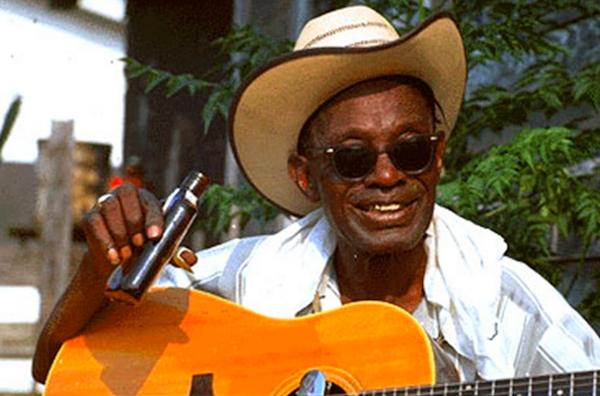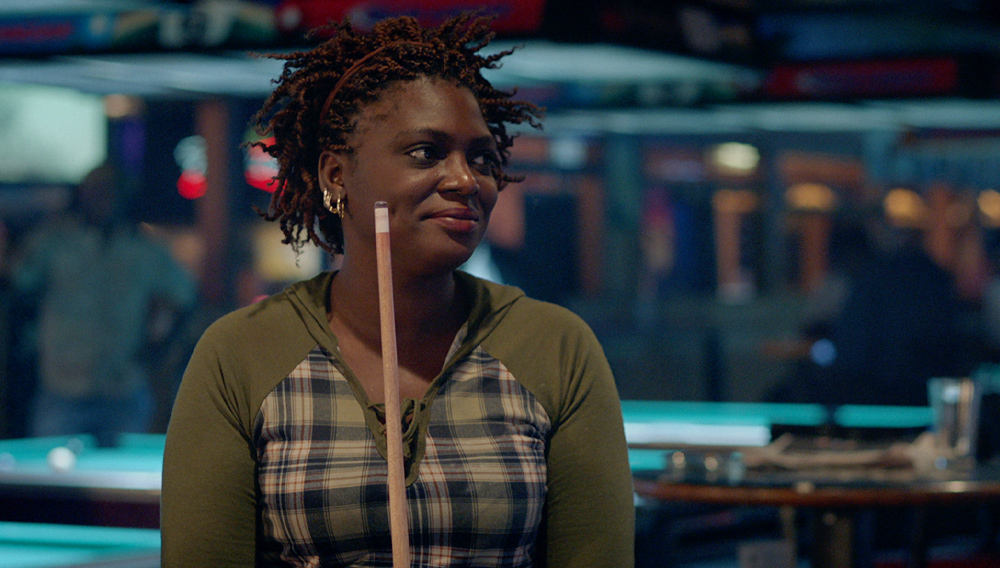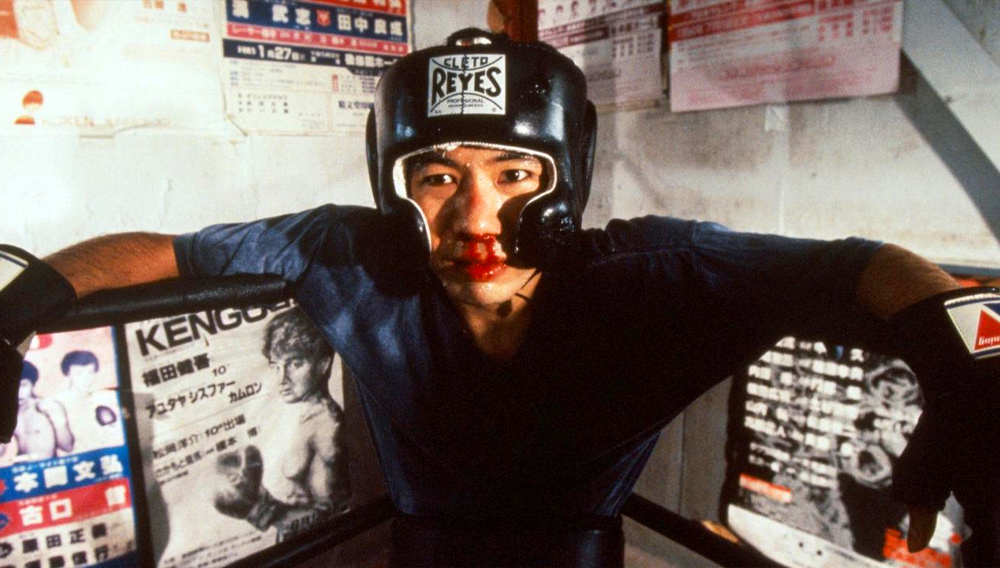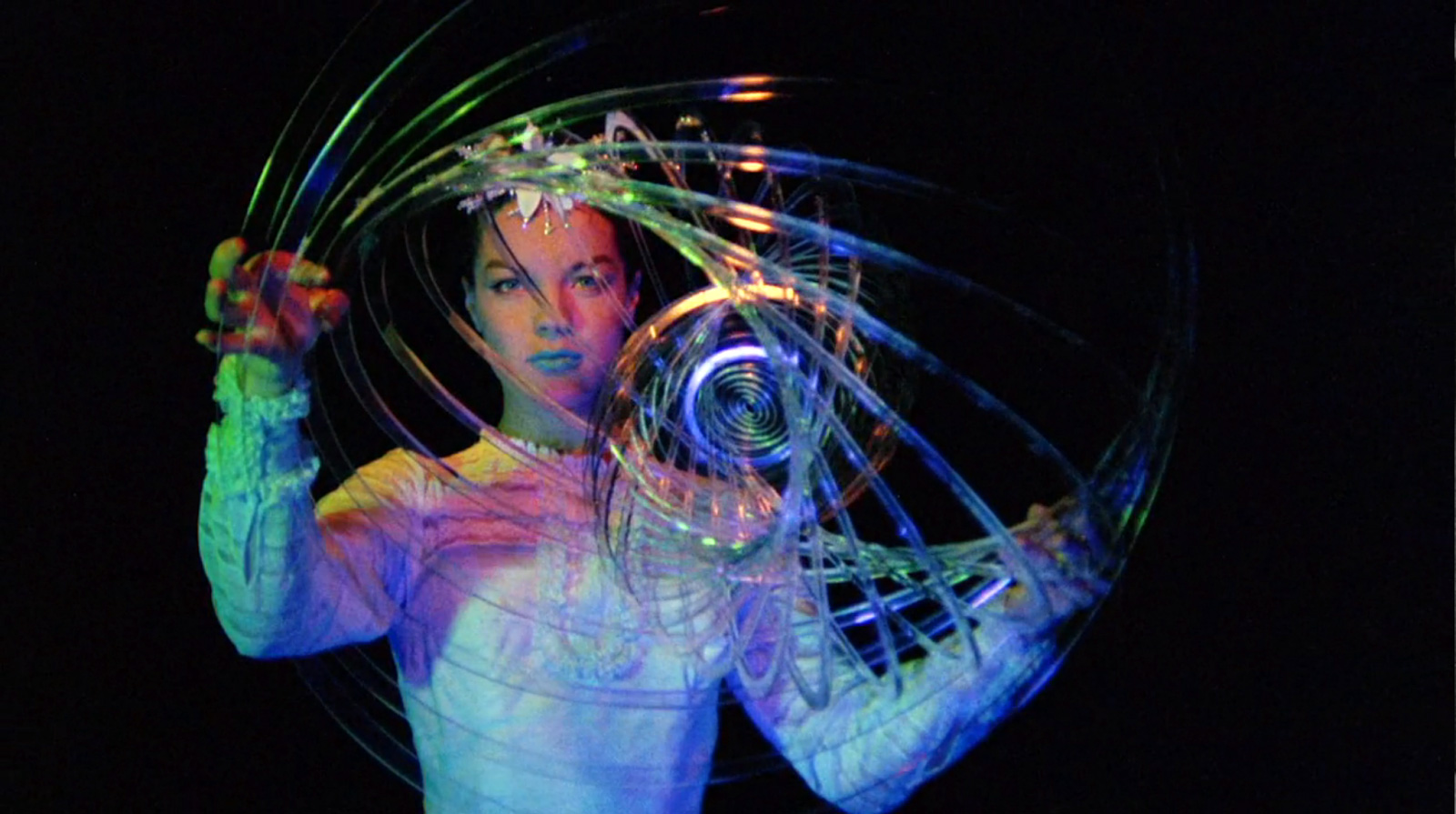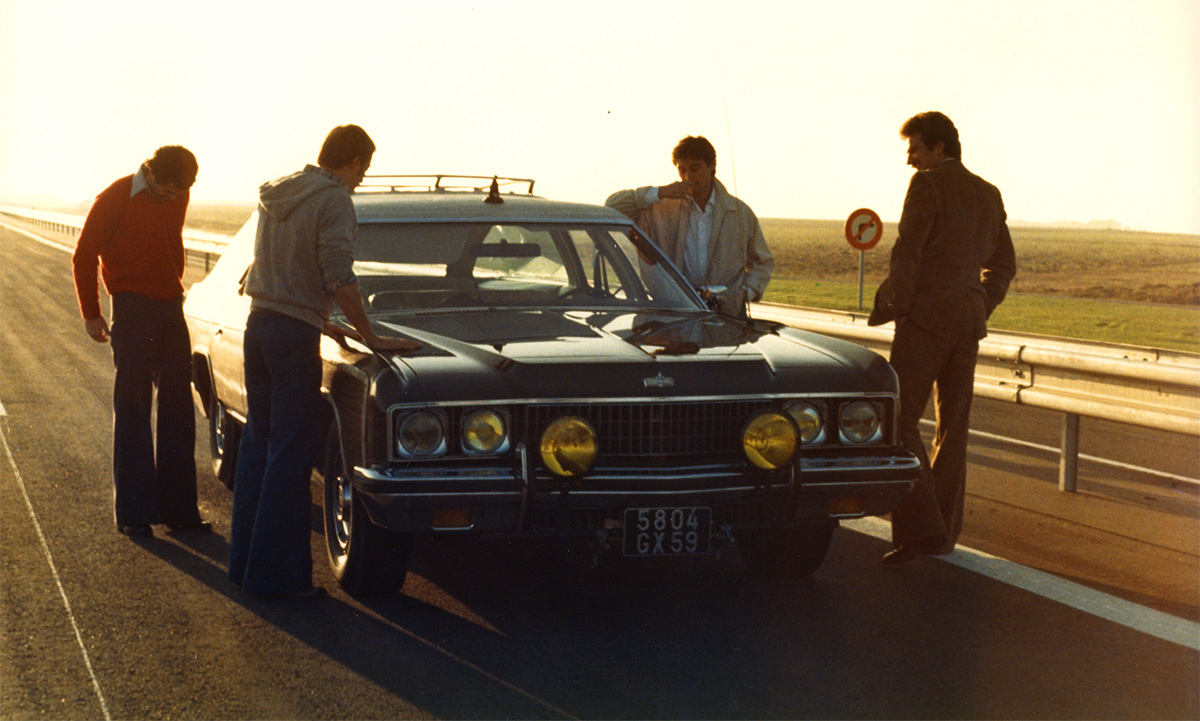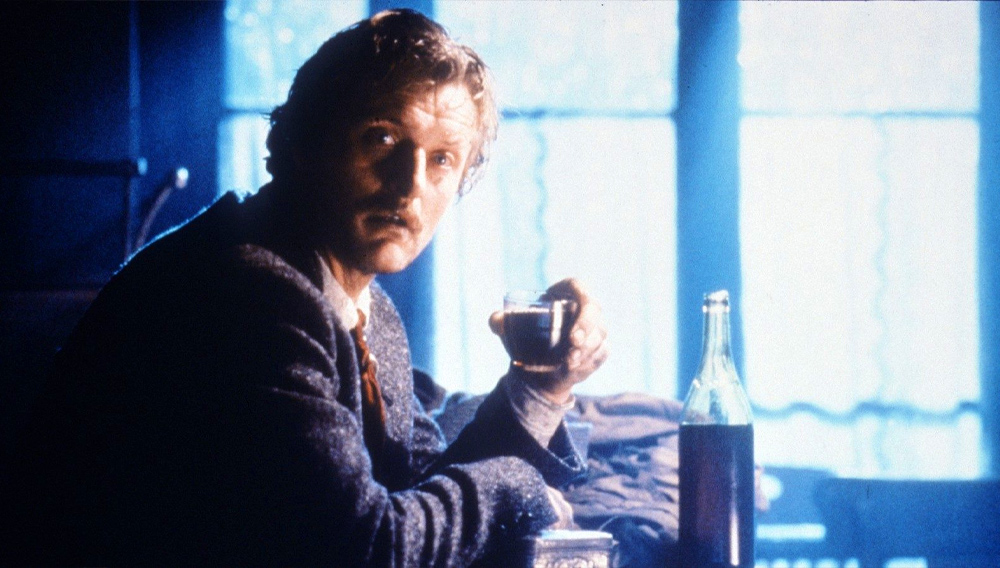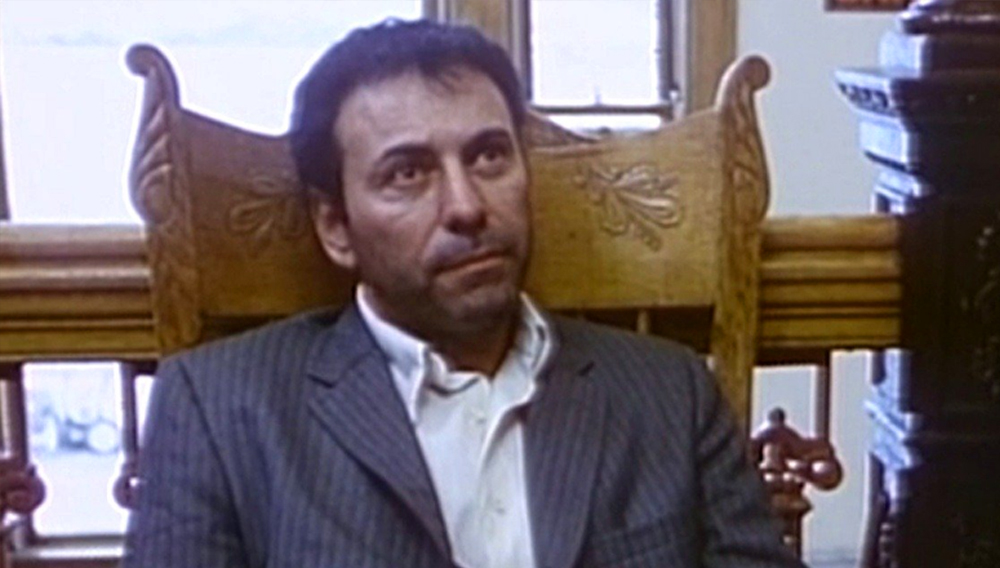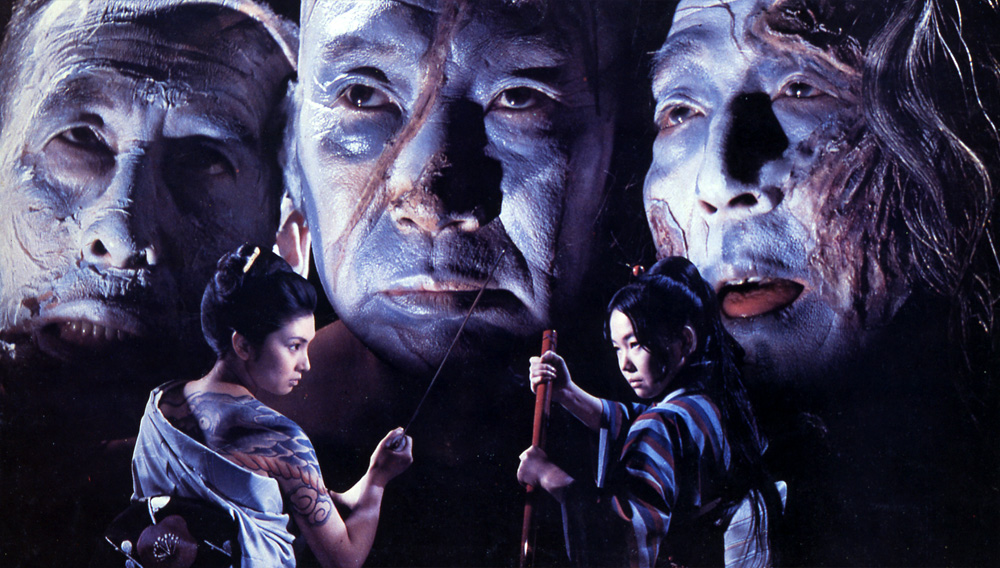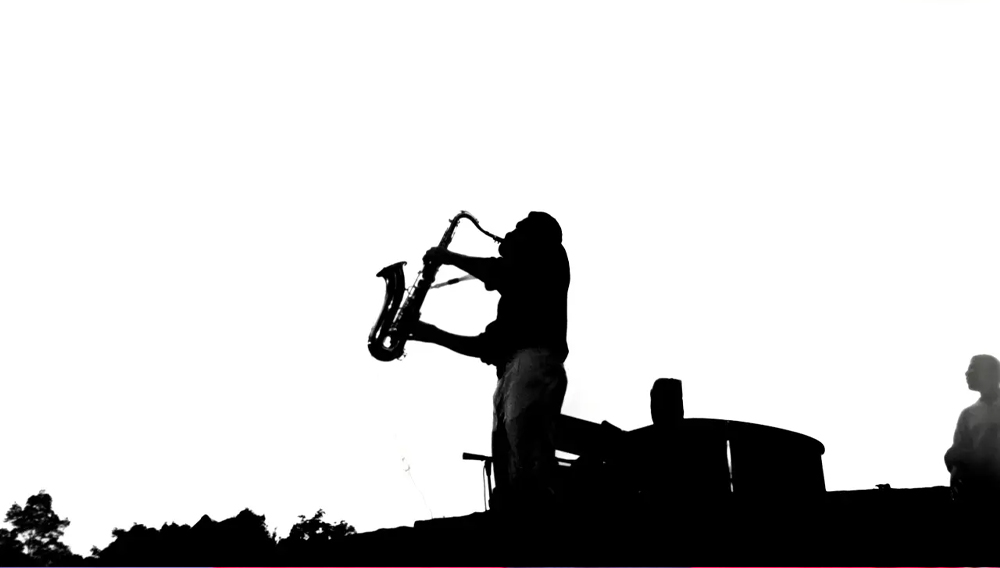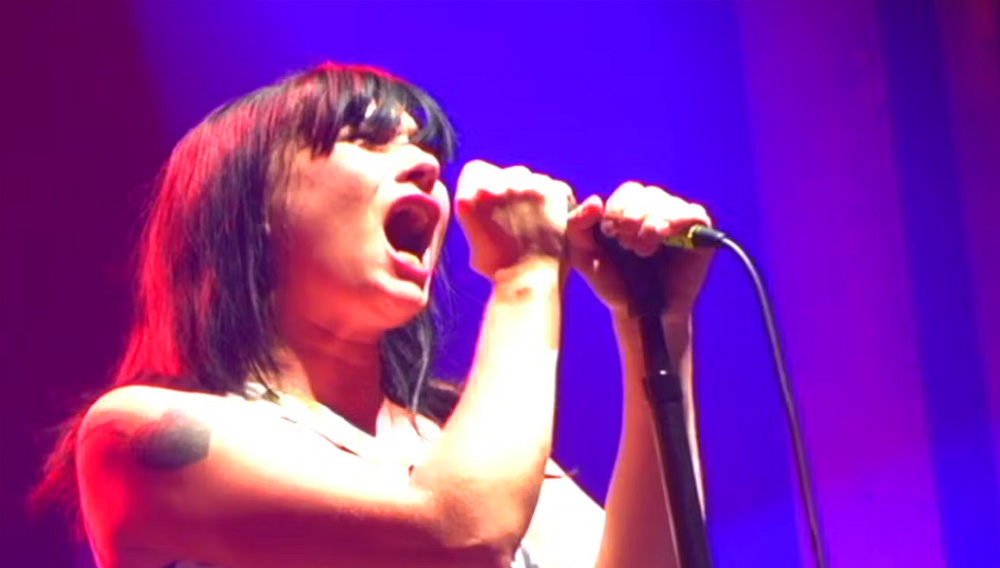[Editor’s note: We re-run this 2007 interview with Les Blank as Fandor newly presents Les Blank films A Well Spent Life and The Blues Accordin’ to Lightnin’ Hopkins courtesy the Criterion Collection and Hulu.]
In more than three-dozen completed documentaries and numerous other fragments and outtakes from films that may never be finished, no one portrayed the perspective of artistic subcultures as uniquely nor as well as Les Blank. Whether it was music or filmmaking or cooking or any other notion that attracted him, Blank had a remarkable talent for capturing a side of his subjects that reached far beyond the efforts of his contemporaries.
After a number of conversations in the years after I relocated to the Bay Area, Les Blank handed me a box filled with VHS copies of nearly every film he’d ever made (with the exception of A Poem Is a Naked Person which I had the pleasure of finally seeing—with Les in attendance, as required—at Ross Rock’s New Nothing Cinema a few years ago) and I immediately proceeded to re-watch them all. Most I had either seen at assorted screenings in Seattle (primarily at programs that I had presented for the purpose of seeing these films with an audience) or, in some instances, documentaries I had rented from Scarecrow Video once upon a time. Seeing them again, all together, was one thing. Talking with Blank a few days later about four decades of filmmaking was something I will never forget. He was generally very reserved when talking about his films. Fortunately, on this occasion—in the days before All in This Tea was scheduled to premiere at the San Francisco International Film Festival—he was more interested than usual in talking about his work.
Jonathan Marlow: I guess that there is no better place to start than the beginning. What was the influence of Ingmar Bergman’s The Seventh Seal on your student film, Running Around Like a Chicken with its Head Cut Off?
Les Blank: Bergman’s Seventh Seal was the film that finally ignited my desire to be a filmmaker. Before that, I liked films but I’d never imagined there was a possibility that I would go into filmmaking. When I saw his film and experienced what I experienced emotionally, I figured that this was it. I had to head in this direction. I didn’t know what steps to take but I would work that out later. The scene where the knight taps the figure on the shoulder, he turns around and it turns out that it’s a corpse… that made a big impression on me. That’s what I was getting at when I have a similar situation in my film.
Marlow: Did you first see The Seventh Seal when you were in college or when you were living in Florida?
Blank: I’d gone to college in New Orleans for four years and got a degree in English. Then I came to Berkeley to go to graduate school in English, thinking that I would keep struggling to be a writer even though, at that point, everything I submitted got rejected. If I failed at that, I thought that I could always teach English. But I was having trouble with my emotions. My first marriage had broken up, I couldn’t concentrate and I dropped out. I just bummed around trying to get work but no one would hire me. After I saw that film, I went to visit the theater department professor who I liked when I was in my last year of school there. He told me that there was a new program in the theater department that offered a Master of Fine Arts in playwriting. All you had to do was write a play instead of a thesis and I saw this as a stepping-stone into film because I would be able to write stage plays and work with actors. It seemed more interesting than flying planes and going to war. It was between the Korean and Vietnam wars. So I did that and, after two years there, I got recommended to go to the USC film school. I got a graduate fellowship there for two years.
Marlow: Was your original intention to make narrative films?
Blank: Yes. I was going to try to follow in the lines of writer/directors like [Luis] Buñuel, [Ingmar] Bergman and [Vittorio] De Sica.
Marlow: Your second film was on Dizzy Gillespie. Had you seen Dizzy perform while you were going to school in New Orleans?
Blank: I like New Orleans jazz. I like traditional jazz. Modern jazz, I could take it or leave it. I wasn’t a total fan of it. When someone asked me if I wanted to work on a film on Dizzy Gillespie, I said, ‘Who’s he?’
Marlow: You were already in Los Angeles when, with God Respects Us When We Work, But Loves Us When We Dance, you documented the Easter Sunday Love-In, the subject of your third film. What made you decide to bring a camera to that event?
Blank: I was supporting the family. I’d gotten married again and my new wife had a baby [filmmaker Harrod Blank]. I had to support us so I had to take whatever I could find that would bring in some money. Industrial filmmaking was what I did. I did films that promoted business and industry, primarily training films and educational films. One of my million employers had an office on Sunset Strip and every lunch-time I’d go out to have my lunch. I would see these Flower Children walking around barefoot, handing out flowers and smiling at people and I wondered, ‘What’s going on here?’ I learned that they’d just started having these weekly gatherings on Sundays called Love-Ins and I went to one and found it interesting. I borrowed my boss’s camera and shot a few 100’ rolls of film, three minutes each roll. Maybe I shot six or seven at one of these events. Meanwhile, one of my schoolmates at USC had a job at the local PBS station, KPFK, and he told me that they were interested in the Hippies, too. I went over there and showed them the footage that I had shot and they said, ‘This is great.’ There was a huge Love-In coming up on Easter Sunday, 1967. The one’s that I’d been watching and partially documented were fairly small gatherings. The station didn’t have any money but, if I agreed to shoot this new one for no pay, they offered to pay for the negative. They would process it at the lab and pay for making a work print, provided I edited the footage into a half-hour piece that they could broadcast. Then they’d give me back the negative and I would own the film. All they wanted was just one broadcast and they would put their own music on, which they did. I went along with that and, again, borrowed my boss’ camera. Thanks to him, I don’t know if he ever knew it or not. I went out and shot one day, Easter Sunday, from sunrise to sunset, shooting non-stop and got the bulk of what’s in that film.
Marlow: Then your cut of the film and the music that you used was different than the version that aired on PBS?
Blank: Yes. I worked with it quite a bit after that although the groundwork was there. It wasn’t really finessed very much when it aired. I went to some kind of party in a ‘haunted house’ type of mansion up in the hills somewhere in the Los Feliz area. I think that it was a benefit for KPFK, actually. The theme of the party was to come as a character from a [Federico] Fellini movie. I rented the costume of an Italian country priest with a big round hat and scared myself when I looked in the mirror. At the party, there was a psychedelic rock band playing music that, to me, sounded like it would go perfect with the footage I’d shot. There were a lot of rock bands playing at the concert but I didn’t get a feed from their mixing panel. I was concentrating mostly on the audience with a few cutaways of rock performers playing. This was also the origin of rock concerts. Before the Love-Ins, there was no such thing as rock music out in the park in the daytime or in clubs like the Whiskey a Go Go. The same boss I worked for used to have an office right above the Whiskey a Go Go before he moved down the Strip. I heard a lot of that music coming through the floor late at night.
Marlow: At what point did you end up relocating from Los Angeles?
Blank: I knocked around Los Angeles for about twelve years. In 1972, I had gone off to Louisiana to shoot a film that later became known as Dry Wood and Hot Pepper with a grant from the National Endowment [for the Arts]. That was my first grant. Nearly at the end of my shooting, I got a call from Leon Russell’s producer. Leon Russell was an up-and-coming rock star and his producer was so pleased with the results of the two films Leon had been in—Joe Cocker: Mad Dogs and Englishmen and The Concert for Bangladesh with Bob Dylan and George Harrison—that they thought, ‘Well, we’ll do another movie and maybe this will help him even more. Besides, we can document all the great and wonderful things this man is going to do with all the money he’s been making.’ They went to the American Film Institute in Los Angeles to ask them about filmmakers who could work with music and they happened to have two prints of mine that I’d submitted for one of the many failed grant attempts I ran through the place for their independent documentary fund. I forget what they called it. The producer saw the [The Blues Accordin’ to] Lightnin’ Hopkins and I think the Cajun film [Spend it All] and he thought I would be the right guy for the job. He called me up in Louisiana and said, ‘We want you to come do a film on Leon Russell.’ I didn’t know who Leon Russell was and I also didn’t know if I wanted to work with some big name talent. I was invited to a film festival in Dallas and went down there from the festival. It was an easy hop from there to Tulsa so they bought me a ticket from Dallas to Tulsa and took me out to this place on the Grand Lake o’ the Cherokees, eighty miles north and east of Tulsa on the Arkansas-Kansas border in the Ozarks. Leon had decided to build this state-of-the-art rock and roll studio and there they would proceed. They had dreams of buying a TV station and making wonderful music…
Marlow: This was A Poem is a Naked Person. It is one of the few documentaries that Flower Films is unable to make available.
Blank: I can’t show it except when I’m personally present at the screening and it’s at a non-profit institution. That’s the way the owner of the film wants it. When the film was finished, I figured that as long as I was there in Oklahoma, I’d live there two years. They supplied me (and my assistant editor and sound-recordist at the time, Maureen [Gosling]) with a weekly paycheck and they fed us. We had a nice place to live on this lake and they had access to this speedboat and to their pickup truck. It was a rather idyllic situation and, after the first year, all the band members got fed up with the rustic living—with the snakes and the spiders and the rough road that their BMWs had trouble navigating—so they built a whole new forty-track recording studio in Tulsa in a church that they bought. They left me and Maureen and the caretakers and this wigged-out artist from Austin named Jim Franklin at the lake place for a solid year of resort living. They brought in the editing machines for me to edit on.
Marlow: You had a flatbed out in Oklahoma?
Blank: I had one of the first KEM flatbeds. At the time, it was the Cadillac of flatbed editing. They sent the brand new machine and a technician out there to show me how to use it. They had three screens and three drives so I could watch three tracks in sync.
Marlow: Sounds idyllic, as you say.
Blank: The exchange for all this was that I could also edit Dry Wood and Hot Pepper at the same time. While I was there, I did my film distribution through the mail and UPS shipped 16mm prints. This was before videotapes, of course. If someone wanted to see a film, they had to rent or buy as 16mm print. I had customers in libraries, film societies, universities and foreign television. I was also having all my raw stock shipped out there from L.A. For any equipment rentals or parts replacements, I would just get on the phone and they would have them there in a few days. I thought, ‘Why live in Hollywood when I could do this anywhere in the world?’ That freed me from the geographical need to live in LA.
Marlow: It wasn’t much later that you landed in Berkeley.
Blank: My second wife, with Harrod and his brother, had moved up to Santa Cruz. Around that time, Tom Luddy had invited me up to show a few films at the Pacific Film Archive. I think I was in their ‘Music and Movies’ series. Before that, we’d had a couple of screenings there and I definitely liked the atmosphere of Berkeley and the reaction of film audiences there. On top of all that, Chris [Strachwitz], owner of Arhoolie Records and the Down Home Music in El Cerrito, wanted me to help him make a film on Texas-Mexican border music, which became known as Chulas Fronteras and, later, an additional film, Del mero corazon.
Marlow: That was the first of the Brazos Films.
Blank: That’s right. This was all in 1975. I’d shot the film for him and he wanted me to edit in his studio in El Cerrito. All of those forces gave me no other option but just to move to Berkeley.
Marlow: You were forced into it…
Blank: It didn’t take much forcing! I hated L.A. The freeways literally drove me insane. I realized that I wasn’t going to be a writer/director of fiction films and there was no need whatsoever to stay down there.
Marlow: We need to backtrack a little bit to two early favorites, both featuring Lightnin’ Hopkins—The Blues According to Lightnin’ Hopkins (which you mentioned briefly) and the short The Sun’s Gonna Shine. How did you meet him and how did you decide to do a film together?
Blank: Shortly after making God Respects Us…, I was in Houston doing one of my many industrial films, a film on the Gulf States Tube Corporation who made pipes for the oil industry. I met a young woman who invited me to an art opening and at the opening was this young man [Skip Gerson] who talked to me and said that he’d like to get into movies. I said, ‘If you’re ever out my way, look me up. Maybe I can give you a job.’ He came out and looked me up and I put him to work as my assistant doing industrial films. He learned enough about filmmaking to be a pretty handy assistant. He also helped me make the Love-In film and became inspired over the whole concept of independent filmmaking. We were together at a folk music club in L.A. called the Ash Grove, which was the Mecca for lovers of traditional folk music and the blues at the time. Lightnin’ Hopkins was performing and I was enjoying him. And my assistant said, ‘I know someone in Houston who knows John Lomax, the only white man that Lightnin’ trusts.’ John Lomax was the brother of Alan Lomax, the folklorist. The two of them and their sister Bess were the children of John Lomax, Sr., who discovered songs like ‘Red River Valley.’ He thought that it’d be nice to do a film on Lightnin’ so he called his father, who was a well-to-do shoe manufacturer, and told him that he wanted to be a film producer. The father was eager for his son to make something of himself and thought, ‘Why not film producer?’ and loaned him $5,000. We went to see Lightnin’ and had a 16mm projector in tow and a print of the Dizzy Gillespie film. I thought that if I could show him this film on a Black jazz artist that he would maybe make the connection and I could do a film on him. I went backstage and asked him if I could show him this film and if would he consider being in the film. He looked at the film and asked, ‘How much money do you boys have?’ I said, ‘Well, we’ve got $5,000,’ he said, ‘That’ll be okay.’ Then we explained that that was not all for him. We had to use some of that for our own purposes, like buying the film stock, getting down to Houston and rustling up some equipment. We finally agreed on $1,500 and we ran off to Houston and shot for a day but he wanted out of the whole thing. He wanted the rest of the money and we had to beg him to let us hang around some more to get more material. I lost all the money I had on me in a little gambling game he played with cards called ‘Pity Pair.’ He had so much fun taking me for the money that he asked me back the second day for another game of cards. I borrowed some money and lost again. He got happy again and asked if I could come back the next day with my camera and resume shooting. We stayed six more weeks.
Marlow: You made a very conscious decision with these early films that remains consistent through all of your work. Like Frederick Wiseman, D.A. Pennebaker, Robert Drew and others, you allow your subjects to speak for themselves. At what point did you realize that this was the direction that you wanted to take?
Blank: At the point when I realized that I didn’t have the intelligence to shape it with my own sense of structure. I just didn’t have the imagination or I didn’t have the skill or the poetic ability it takes to force a film into a form like that. When I was making all of these industrial films, they were heavy with narration from wall to wall. I had to write these narrations and I hated doing it. I started off trying to write a standard script for the Lightnin’ film and it just never worked. Finally, in desperation, I just started throwing scenes together. I found that there was something pleasurable in just cutting pictures like you would notes of music in a music score.
Marlow: Your films have a real handmade quality to them. Obviously, in the earliest films, the titles were all hand-painted. The films often seem constructed out of the moments that other people would leave out of the film, like cooking and drinking and people just sitting around. That’s what makes your films particularly charming because you see people as they really are as opposed to some construction that’s created for the camera.
Blank: These are things that interested my eye and I’ve found that audiences liked it, too. It’s provided a more direct communication between the audience and the people in the film.
Marlow: There’s an outtake, or a short, that you gave to me called Mr. Charlie that’s not part of your official filmography. I presume that is taken from the same period?
Blank: It was an outtake that was too long. In order to benefit from the piece, you have to watch the whole story. It just took too much time to stick it into the film. It had a whole different rhythm from the film. I enjoyed the song and the story behind it and didn’t want to lose it. I have more outtakes and one of these days I’d like to go through and pull them out.
Marlow: Is it true that with the Brazos Films, Arhoolie has a soundtrack that accompanies each film? I know of one for Chulas Fronteras…
Blank: There are two for J’ai ete au bal [I Went to the Dance].
Marlow: You’re more generous than most filmmakers to elevate the relationship of your co-conspirators in creating films by listing the films as a work by yourself and them. Your primary collaborator—your sound-recordist, your producer, your editor—often receives co-director credit [such as Gina Leibrecht on All in this Tea]. I was curious about your working relationship with Maureen Gosling, Chris Simon and others.
Blank: The first partnership was Flower Films which I started with Skip [Gerson]. I have a fondness for flowers. When I trained my eye to be a photographer, I shot a lot of flowers and found them endlessly fascinating. Our friendship and business partnership fell apart in 1972. Then, Maureen was an eager, bright-eyed anthropology graduate fresh out of University of Michigan at Ann Arbor. I met her in her senior year and, when she graduated, she asked if she could come to work for me. At that point, I had just broken up with my business partner and needed some help. I didn’t have any money to pay anybody and she was willing to do anything and go anywhere, so I took her to Louisiana. I didn’t know her at all. I taught her how to run the Nagra and she learned quickly in the field by making mistakes. We shot Dry Wood and Hot Pepper that way. She stuck around when I lived in Oklahoma for two years and proceeded as an assistant editor on Dry Wood and the Leon Russell film. Then, I sort of bounced around for a while ‘til I got going on Chulas Fronteras and she came back to be my assistant on that. I did Werner Herzog Eats His Shoe and Garlic Is as Good as Ten Mothers in tandem. I edited most of the films myself but she came on and I worked with her to finish them off and I gave her the editing credit. My co-filmmakers and I argue mostly over ‘film with’ and ‘film by.’ It was a fine line we tread and we fought about it constantly.
Marlow: Two of the films you mentioned [and, later, Burden of Dreams] feature Werner Herzog. Obviously, both of those films involve, in some sense, Tom Luddy and Alice Waters. Was it yours or Tom’s or Alice’s suggestion to cook the shoe at Chez Panisse?
Blank: That was my suggestion. I knew Tom pre-PFA. He was showing the Lightnin’ film when he was booking the Telegraph Repertory Cinema. I believe the famous film reviewer from the New Yorker, [Pauline] Kael, was there writing program notes. I’d actually gone to that theater when I was in my last period in Berkeley graduate school when she was programming and writing the notes. Then later, either that theater or one similar to it, Tom programmed the Lightnin’ Hopkins film. He invited me up to meet me and he was living with Alice at the time. She was teaching at the Montessori school but she’d already been to France on her junior year abroad and got hooked on French ways of cooking and food handling. I enjoyed the fruits of her learning and I enjoyed her. I was very fond of her as well! I hung out at Chez Panisse as often as I could.
Marlow: The idea is taken from an offhanded comment that Werner made to Errol Morris. Were you already aware of this story long before the event?
Blank: I didn’t know much about Errol or the film. I just knew that Werner was on his way to Berkeley to eat his shoe. He claims he made a vow to Errol for the first time his film showed in Berkeley. The film got finished and was about to have its premiere at the UC Theater, which was the first theater in the Landmark chain co-founded by Gary Meyer. Tom suggested that I might want to do a film on it and Werner agreed to let it be done.
Marlow: At what point did you incorporate the Charlie Chaplin footage from The Gold Rush?
Blank: I was working with the footage and I saw Werner eating the shoe. I remembered one of my favorite scenes from a Chaplin film was Charlie eating his shoe in The Gold Rush. I thought it might be fun to play with that in there and tried it and it worked just fine.
Marlow: There is such a love for people in Garlic Is as Good as Ten Mothers and an obvious adoration for the stinking rose. Does your interest in garlic go back to your exposure to Cajun cooking or before?
Blank: Garlic was one of those things, like snakes, that I grew up around. This was a culture of people who were afraid of snakes and they’d kill every one that they saw. Anything that was dark was a cottonmouth water moccasin and you’d better kill it before it kills you. Anything resembling a rattlesnake, even if it has no rattles on its tail, could kill you. When they saw snakes, they screamed. Snakes were thought of as Satan in disguise and all that stuff. I was always attracted to things in the culture that people were bothered by. Garlic was something that I would notice that people would say, ‘Don’t eat too much of that or you’ll smell like garlic.’ It caught my interest to explore what was so provocative about garlic. I noticed that I tended to like the foods that used garlic more than other foods.
Marlow: If you were spending a lot of time at Chez Panisse, I presume you were exposed to a bit of garlic there.
Blank: Yeah. I’ve always liked garlic bread. Garlic breath didn’t bother me. When Alice came up with the idea to do a festival around garlic it gave me the excuse to hang out around her and her restaurant and eat her food and watch her. That was the sole impetus to make that film.
Marlow: Werner appears in both of those films [Werner Herzog Eats His Shoe and Garlic Is as Good as Ten Mothers]. Later, you were invited to go and document the filming of Fitzcarraldo. How did you come to publish your letters about the filming?
Blank: After it was done, I was traveling around and showing the film. One of the places that I showed The Burden of Dreams was at the University of Arkansas. There was a man there in the art department who liked my films and said that he would like to have me out there to show them to his students in the art department. I had a little tour where I would go there and then Kansas City, St. Louis and maybe Chicago. One day he was driving me down to Kansas City and we discussed the idea of doing a book. I told him that I had written these letters to my girlfriend while I was down there. He was interested in reading them and he had his staff type them out and then he edited them into the book.
Marlow: I presume, when it was originally published, that the book was longer than the version that is included with the Criterion disc?
Blank: Much longer, yes.
Marlow: The Criterion version is merely a digest.
Blank: I don’t think it’s very accurate. It seems like I’m always wanting a beer (which is true but it seems to be more weighted towards my thirst for beer [than the complete version]).
Marlow: Like we discussed earlier, your films generally have no commentary or narration but Burden of Dreams has commentary throughout. Was this at PBS’ insistence? Was it at all difficult to get used to editing the film with this stylistic difference?
Blank: Actually, I was trying to figure out a way to put the film together without narration and I got the distinct feeling from the PBS people that they were expecting narration. Thinking through it all, I realized that maybe narration wouldn’t be so bad after all. The story is kind of complicated to tell. Usually, I would have someone in the story, like Werner [Herzog] himself, tell the story of Fitzcarraldo and usually I can piece together some kind of structure just from what the subjects have to say on their own. This time it seemed like the film could benefit from an external narration. I worked really hard with the writer Michael Goodwin to make it almost like haiku poetry. It is sparse and each time he says something—something that really ties things together—it doesn’t create added weight. I don’t think that it’s obnoxious. Narration is usually just way overdone and not needed. It gets in the way of the emotions and the aesthetics of the filmmaking itself.
Marlow: If one could say that anything unites all of your films, it is a particular embrace of nonconformists. Obviously Werner falls into such a classification but perhaps most important is the handful of films you made with Marc Savoy. Spend it All begins with handmade titles that describe the history of the Cajuns, covering Arcadia and the whereabouts of where those people end up. When we first see Marc in that film, appropriately enough he’s cooking. Did you discover the Savoy Music Center before settling in to make Spend it All or did you find Marc and Ann during the shooting process?
Blank: That was a surprise learning experience once I started. I was told that there was this guy that I had to meet. So I went over to the store to see who this guy was. He was a likable guy but he wouldn’t let me film him because he was in a hurry to go out in the bayou and drink some beer and cook some food. He told me that I could bring the camera and shoot it but, by the time he finished up his work in the store, it was too dark to shoot when we got to the bayou. This went on about three times. We waited until the last day of shooting when he was actually available during the sunlight hours. We killed a pig.
Marlow: You show Marc making accordions, a rather unusual instrument to fabricate without any real training. The book that his wife, Ann, wrote—Cajun Music: A Reflection of a People—is the foundation for J’ai ete au bal/I Went to the Dance. How important was the celebratory mixing of music and food to the evolution of each component? Each seems to be influenced by the other.
Blank: I don’t know. The two go together very well, at least around the people I hung around with. Marc is always surrounded by live music. All families had musical instruments. They all could sing, they all could whistle and I think they all could dance. This was the way that most all cultures, including Americans, have been…
Marlow: …until recently.
Blank: Right. Any celebratory moment requires special care on the food and it also requires music to liven the spirits. There’s always some kind of food at the dances. Something tasty.
Marlow: I’m going to go off a ledge here

